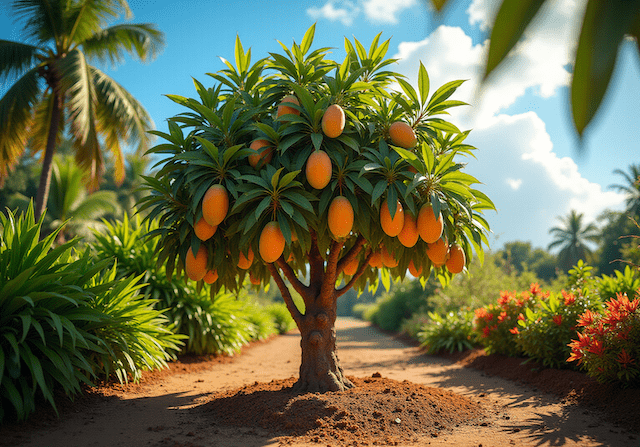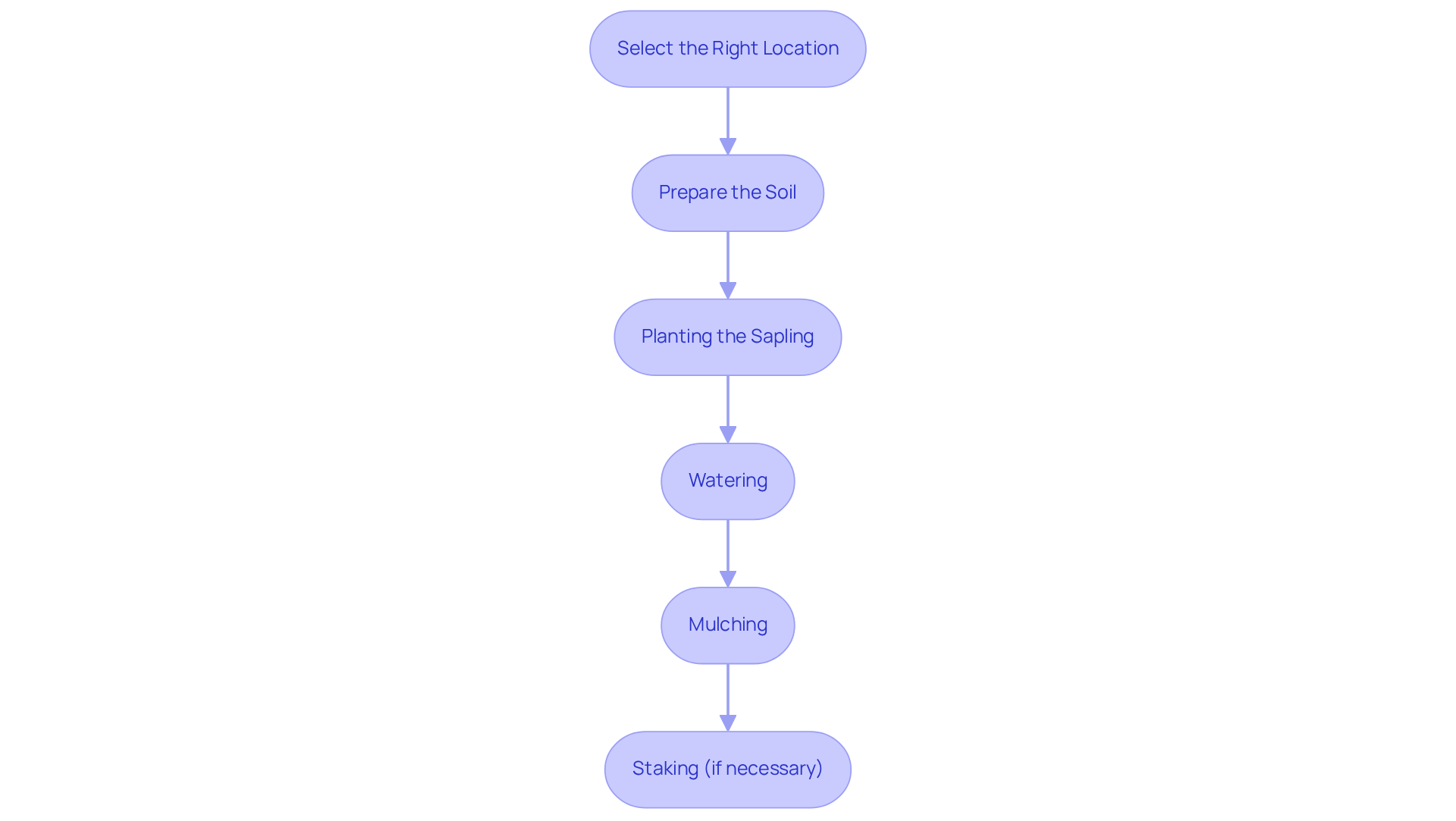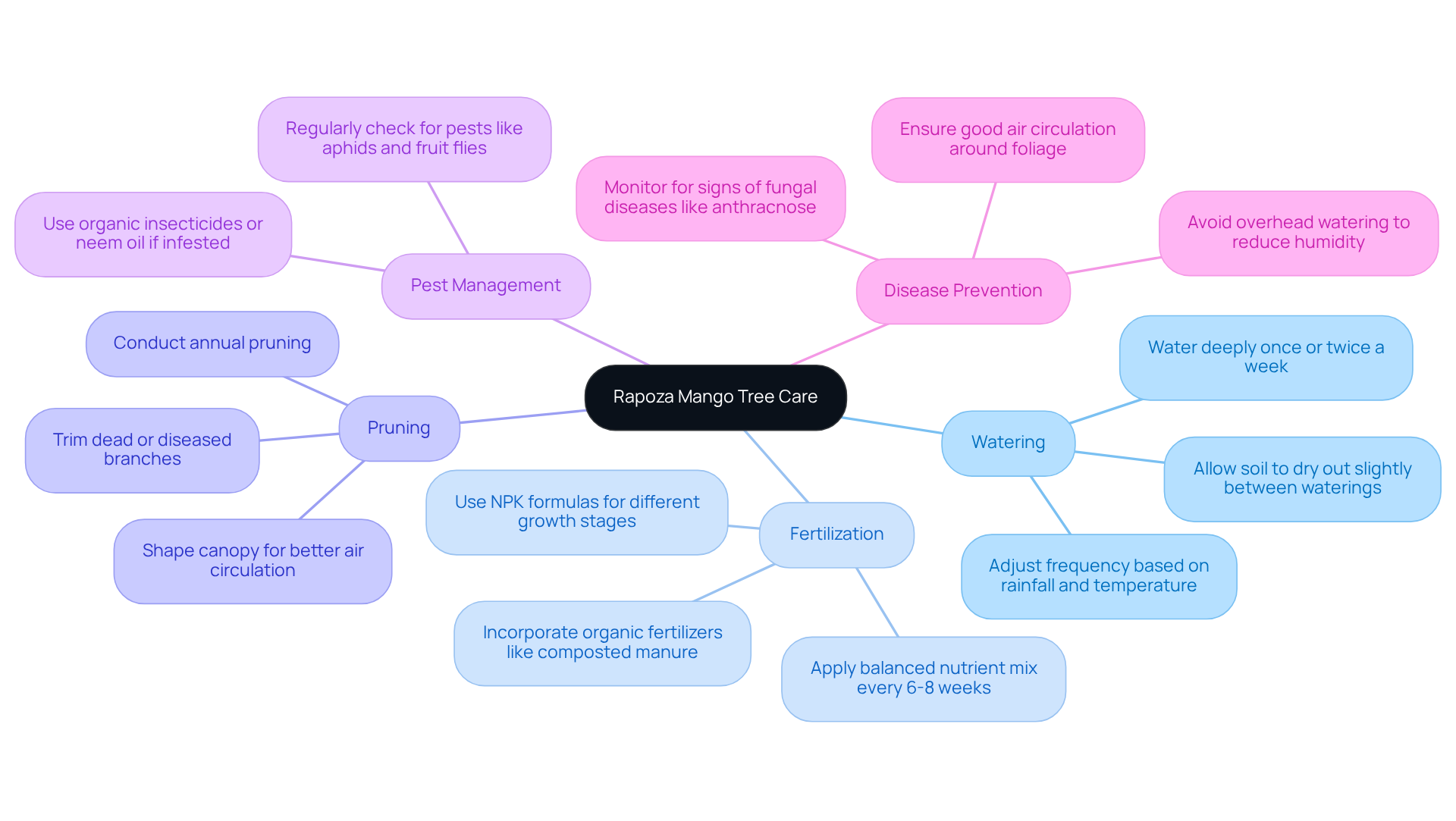
Grow Rapoza Mango Trees: Essential Steps for Home Gardeners
Share
The allure of growing Rapoza mango trees captivates many home gardeners, promising the sweet reward of fresh, tropical fruit right from their backyards. Understanding the specific conditions these trees require is crucial for success. They thrive in warm, sunny environments with well-draining soil and consistent moisture. However, the journey to cultivating a flourishing Rapoza mango tree is not without its challenges.
What happens when environmental factors or pests threaten to derail the growth process? This guide delves into the essential steps for planting, nurturing, and troubleshooting common issues. By following these guidelines, gardeners can enjoy the fruits of their labor for years to come.
🥭 Want to grow a namgo tree in your garden?
Explore Rapoza Mango Trees for sale at Everglades Farm - shipped directly from Florida.
Understand the Growing Conditions for Rapoza Mango Trees
Rapoza mango plants thrive in warm, tropical climates and need full sun exposure for optimal growth. They prefer well-draining sandy loam soil with a slightly acidic pH, ideally ranging from 5.5 to 7.5. These plants favor temperatures between 70°F and 100°F and necessitate humidity levels exceeding 50% for their best development. Although they can withstand brief periods of drought, consistent moisture is crucial for their growth. It is essential to choose a planting site that is sheltered from strong winds, as these can damage the delicate flowers and fruit. Additionally, gardeners must be aware that these plants cannot survive freezing temperatures. When selecting a planting site, consider the mature size of rapoza mango plants, as these can grow significantly large, requiring ample space for their roots and canopy to spread.
Everglades Farm offers a diverse selection of tropical plants, including the rapoza mango, as part of our Fast-Growing Plants collection. This collection caters to home gardeners seeking quick-yield tropical plants, ensuring that you can enjoy the fruits of your labor in a timely manner. With our professional-grade fertilizers, you can provide the ideal nutrients that your rapoza mango plants need for healthy growth and abundant yields.
Key Growing Conditions:
- Sunlight: Full sun (at least 6-8 hours daily)
- Soil: Well-draining sandy loam, slightly acidic
- Temperature: 70°F to 100°F
- Humidity: Above 50%
- Watering: Regular moisture, but avoid waterlogging
- Protection: Shield from strong winds
Plant Rapoza Mango Trees: Step-by-Step Instructions
-
Select the Right Location: Choose a sunny spot with well-draining soil, ideally away from other plants that may cast shade. This ensures that your rapoza mango plant receives the necessary sunlight, which is crucial for its growth and yield. As gardening expert Melissa Strauss notes, "The best fruit comes from plenty of early sunlight daily."
-
Prepare the Soil: Dig a hole that is twice as wide and deep as the root ball of the plant. Mix the excavated earth with compost to enhance fertility, creating a nutrient-rich environment that supports healthy root development. Mango plants thrive best in slightly acidic to neutral soil, ideally with a combination of sand and organic materials.
-
Planting the Sapling: Position the sapling in the center of the hole, ensuring that the top of the root ball is level with the surrounding soil. Fill the hole with the prepared earth mixture, gently compacting it around the roots to eliminate air pockets.
-
Watering: After planting, water the plant thoroughly to help settle the soil around the roots and remove any air pockets. During the initial establishment phase, young mango plants require frequent watering, transitioning to once every two weeks as they mature. This deep watering is vital for developing a strong tap root, which is essential for stability.
-
Mulching: Apply a layer of mulch around the base of the plant to retain moisture and suppress weeds. Ensure the mulch is kept a few inches away from the trunk to prevent rot and encourage healthy growth.
-
Staking (if necessary): If the plant is tall or located in a windy area, consider staking it for support until it establishes a robust root system. This helps prevent damage and ensures stability as the plant grows.
Expert Insight: Landscape designers emphasize that proper ground preparation and planting techniques are critical for the successful establishment of fruit plants. They recommend regular monitoring of soil moisture and nutrient levels to ensure optimal growth conditions. Additionally, it typically takes five to seven years for these plants to fully establish after planting, so patience is key.

Maintain Your Rapoza Mango Trees: Care and Management Tips
Watering your rapoza mango is essential for the health and growth of the plant. Water deeply once or twice a week, adjusting the frequency based on rainfall and temperature. It is important to allow the soil to dry out slightly between waterings to prevent root rot, ensuring the plant receives the right amount of moisture.
Fertilization plays a crucial role during the growing season, specifically in spring and summer. Apply a balanced nutrient mix designed for bearing plants, following the package instructions, which typically recommend applications every 6-8 weeks. This practice supports optimal growth and fruit production.
Pruning should be conducted annually to maintain the health of the plant. Trim away dead or diseased branches and shape the canopy to encourage better air circulation and sunlight penetration. This not only promotes a healthier plant but also enhances the quality of the rapoza mango.
Pest management is vital for the well-being of your rapoza mango plant. Regularly examine it for pests such as aphids and fruit flies. Should you encounter an infestation, consider using organic insecticides or neem oil to manage the situation effectively without harming beneficial insects.
Disease prevention is equally important. Keep an eye out for signs of fungal diseases like anthracnose. To minimize humidity around the foliage, ensure good air circulation and avoid overhead watering. These practices will help protect your plant from potential threats.

Troubleshoot Common Issues in Growing Rapoza Mango Trees
-
Leaf Yellowing: This symptom often signals overwatering or nutrient deficiencies. Assess the soil moisture levels and consider applying a balanced fertilizer to restore nutrient balance. As noted by Amir Rezazadeh, symptoms of infection can include leaf wilting and browning, which may indicate underlying issues.
-
Poor Fruit Set: If your Rapoza mango plant blooms but fails to produce fruit, the causes may be insufficient pollination or environmental stress. Pollination success rates can be low, with naturally pollinated flowers exhibiting set percentages of only 3.1% for Chok Anan and 4.8% for Sala. Ensure the tree is placed in an area with good airflow and consider hand-pollination to improve yield.
-
Pest Infestations: Swift action is crucial if pests such as aphids or flies are identified. Treat affected areas with insecticidal soap or neem oil, and promptly remove any infested fruit to prevent further issues.
-
Fungal Diseases: Be vigilant for signs of anthracnose or powdery mildew. The most significant disease impacting mango plants in Florida, anthracnose, can lead to severe damage. Enhancing air circulation around the plant and using fungicides as needed can assist in managing these outbreaks efficiently.
-
Fruit Drop: Excessive fruit drop may result from stress due to drought or overwatering. Establish a consistent watering schedule and monitor environmental conditions, such as high temperatures and humidity, to minimize stress on the tree.
Conclusion
Growing Rapoza mango trees can be a rewarding endeavor for home gardeners, provided the right conditions and care practices are followed. These tropical plants flourish in warm climates with ample sunlight, well-draining soil, and consistent moisture. Understanding their specific needs is crucial for successful cultivation, from selecting the ideal planting site to managing ongoing care and addressing potential challenges.
Key insights from this guide highlight the importance of:
- Proper soil preparation
- Regular watering
- Timely fertilization to promote healthy growth and fruit production
Additionally, annual pruning and vigilant pest management are essential components of maintaining the vitality of Rapoza mango trees. Awareness of common issues such as leaf yellowing, poor fruit set, and fungal diseases equips gardeners with the knowledge to troubleshoot effectively and ensure their plants thrive.
Ultimately, nurturing Rapoza mango trees not only enhances the beauty of a home garden but also provides the joy of homegrown fruit. By implementing the steps outlined in this guide and remaining attentive to the plants’ needs, gardeners can look forward to enjoying the delicious rewards of their labor. Embrace the journey of growing these magnificent trees, and relish the satisfaction that comes from cultivating your own tropical paradise.
Transform Your Garden into a Tropical Paradise!
Start growing Rapoza mango trees today and enjoy the sweet rewards of home gardening.
🛒 Buy a Rapoza Mango tree
🌱 About Everglades Farm
Frequently Asked Questions
What climate conditions are ideal for Rapoza mango trees?
Rapoza mango trees thrive in warm, tropical climates with full sun exposure for optimal growth.
What type of soil is best for planting Rapoza mango trees?
They prefer well-draining sandy loam soil with a slightly acidic pH, ideally ranging from 5.5 to 7.5.
What temperature range is suitable for Rapoza mango trees?
Rapoza mango trees favor temperatures between 70°F and 100°F.
What humidity levels do Rapoza mango trees require?
These plants necessitate humidity levels exceeding 50% for their best development.
How often should Rapoza mango trees be watered?
They require consistent moisture for growth but should not be waterlogged.
Can Rapoza mango trees withstand drought?
While they can tolerate brief periods of drought, consistent moisture is crucial for their growth.
What protection do Rapoza mango trees need from environmental factors?
It is essential to choose a planting site that is sheltered from strong winds, as these can damage the delicate flowers and fruit.
Are Rapoza mango trees resistant to freezing temperatures?
No, Rapoza mango trees cannot survive freezing temperatures.
How large do Rapoza mango trees grow?
Rapoza mango trees can grow significantly large, so ample space for their roots and canopy to spread is necessary when selecting a planting site.
Where can I find Rapoza mango trees for planting?
Everglades Farm offers a diverse selection of tropical plants, including Rapoza mango trees, as part of their Fast-Growing Plants collection.


